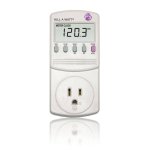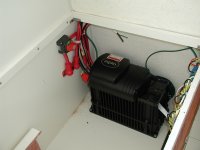Rob brings up several good points, in that one needs to know the actual power draw of an appliance. The best tool for this is an inexpensive meter called Kill-A-Watt.

This is listed at less than $20 at Home depot.
I always check appliances with this device. It reads volt watts, amps and kilowatt hours over time. Plus frequency in Hz and mains line voltage. It plugs into the 110V mains outlet, and then the appliance plugs into it. It may not reflect the surge current, but most inverters are meant to handle at least twice their capacity in surge. Fortunately for microwaves this is a factor of 2, but many appliances such as a refrigeration compressor have a factor of 5. The heating element in the coffee maker inrush current is very short as the heating element comes to temperature--in microseconds. Some appliances may take longer periods to come to full power, and thus the inverter may have to be sized larger and / or have a higher surge capacity.
The Killowatt hours gives some idea of how much it will draw from the battery over a timed period (multiply by a factor of 10 for an approximation of the 12 volts to 120 volts.)
Some quick reading on the Tassimo coffee maker shows that it only runs the element for 30 seconds--it that is true, then that is why the group 24 battery has not significantly changed....but I would never suggest a group 24 battery for a load of 1000 watts. This may also be why the 800 watt inverter has not failed. Overloading puts both the inverter and appliance at risk.
In less than 20 minutes 100 amps out of the group 24 battery would take it to 50% discharge point--and any more would be harmful to the battery.....(a voltage of 12.2 volts, resting.) (Capacity of group 24 is generally about 60 amp hours, 20 minutes of 100 amps about 30 amps.)
Also the wiring for an inverter must be very robust. For 100 amp draw if the inverter is 10 feet from the battery (20 foot round trip) you should be using # 2 Gauge wire, and if 110 amps then # 1 wire. When I put the 1500 watt inverter in the Tom Cat for a microwave, I placed two group 31 AMG batteries into the cabin, only a couple of feet from the inverter under the aft dinette seat, and used #2 wire for the short run of only a couple of feet to the fuse, and the inverter.
Like the Meter I mentioned above, the DC amp meter may not fully reflect the inrush or surge current.


